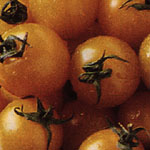



FoodFood InformationVegetables
Tomatoes, which are native to South America, are available twelve months
of the year. In the United States, California and Florida are the major
producers, although during the summer months tomatoes are grown locally
in most of the other states. During the winter months tomatoes are imported
from Mexico in huge quantities, and in far lesser amounts from Europe and
Israel, to supplement our own production.
Originally tomatoes were yellow in color, but these are now an oddity, more
than 99 percent of the ones produced in the United States are red. Along
with the traditional sized and round-shaped garden varieties of tomatoes,
there are some types that are plum-shaped. There are also miniature tomatoes,
not much bigger than marbles, called cherry tomatoes, which have been showing
an annual gain in popularity.
Tomatoes were first introduced in Europe as curios by the explorers returning
from the New World. In many areas of Europe it was believed that the tomato
was poisonous because it was of the same botanical family as belladonna,
a known poison.
This unwarranted fear was brought to North America by the early settlers,
but it wasn't until the late nineteenth century that we accepted the tomato
as a wholesome, flavorful, nontoxic, fresh food. Today the tomato ranks
third in the annual tonnage of fresh vegetables used in the United States.
(Potatoes rank first and lettuce, second.)
There has always been some dispute as to whether the tomato is a fruit or
a vegetable. Since it is a berry it is botanically classified as a fruit.
However, in the marketplace it is classified as a vegetable by the consumer,
and the customer is always right!
Depending on your geographical location and the time of the year, you will
be offered two kinds of tomatoes: vine-ripened and force-ripened. They'll
look alike but won't taste alike. Tomatoes are at their flavor best when
they are harvested after they reach full color. They will lack flavor if
harvested while still green and then force-ripened.
The best tomatoes with full flavor are those that aren't picked until they
reach full color. But even those that are picked while only starting to
turn pink will ripen up to near-full flavor. Tomatoes of this quality are
like the ones you would grow in your own backyard and are usually available
when grown locally during the summer months. They are very delicate and
fragile and must be picked, packed, transported, and marketed with utmost
care to prevent bruising or crushing.
Some vine-ripes are available during the off-season in the winter months,
but most of the domestically grown supply is down to a trickle because nearly
all the Florida and California growers prefer to sell the consumer the green
rather than the ripe tomato. In the winter some vine-ripes arrive via truck
from Mexico and only a few come in via air from Europe and Israel. There
are also hothouse tomatoes, and this supply helps fill the seasonal gaps.
The supermarket tomato is a vegetable of the same color, but it has a different
flavor. These are picked while still grass-green. The growers claim that
they are "mature" greens, but green is green. Green tomatoes are
harvested, washed, graded, and packed by machine. Either at the source,
in transit, or upon arrival at the wholesale terminals and chain-store warehouses,
they are exposed to warmth and usually to ethylene gas. This combination
of heat and gas force-ripens the tomatoes. They change in color from green
to pink to a rosy red. At this point they look very much like the flavorful
super vine-ripes, but they lack flavor and are often too hard to be juicy.
Note that the ethylene gas used to ripen the tomatoes is the same product
used to ripen bananas. It is harmless and is a duplicate of the natural
gas exuded by many fresh fruits, including tomatoes.
To the growers, force-ripened tomatoes mean a lot more cash for their crop
because the labor costs are only a fraction of those needed to produce vine-ripened
tomatoes. There is also a far greater yield per acre because there is less
chance of damage in the field from rain, wind, or hail, and there is little
or no loss due to damage in transit. Supermarkets love the force-ripened
tomatoes because they are almost indestructible. They require no extra help
or care. Even if they are handled like coal by careless employees or overzealous
self-service shoppers, the supermarket tomatoes endure. Similar treatment
to vine-ripes would result in a transformation to ketchup or tomato juice.
But during the winter months especially, consumers have to settle for less
than flavorful tomatoes.
Unfortunately, even at the peak of season during July and August, when so
many areas have locally grown tomatoes that are readily available, most
of the supermarkets and many smaller stores continue to handle the same
flavorless tomatoes they offered all winter. But at least during the summer
the consumer can shop for homegrown vine-ripened tomatoes at road stands
or in some of the more specialized fruit stores.
Whenever the vine-ripe tomatoes are not available, try switching to cherry
tomatoes or plum (roma) tomatoes. They usually have more flavor than the
force-ripened tomatoes.
Tomatoes don't like and do not ripen properly or at all (depending on the
maturity of the tomato) if stored under refrigeration. Unfortunately, while
there is a vast difference between the flavor of vine-ripened and force-ripened
tomatoes, they look very much alike.




WHEN TO BUY: Available year-round
WHAT TO LOOK FOR: Vine-ripened, full-color fruit
HOW TO STORE: Ripen at room temperature; refrigerate only after fully ripened
and only if temperatures exceed 75F.
Deamer 5/97